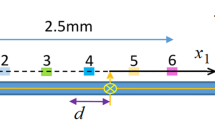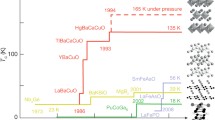Zusammenfassung
The question of how exactly the electrical resistance in superconductivity disappears to zero came into focus in the early 1960s, when newly discovered superconductor materials first appeared to make their technical applications at high electrical currents possible. Especially, the new superconducting niobium alloys Nb3Sn and NbZr were very promising. Careful measurements, especially at the Bell laboratories in the USA, revealed indications of high values of critical electric current density and critical magnetic field.
Access provided by Autonomous University of Puebla. Download chapter PDF
Similar content being viewed by others
The question of how exactly the electrical resistance in superconductivity disappears to zero came into focus in the early 1960s, when newly discovered superconductor materials first appeared to make their technical applications at high electrical currents possible. Especially, the new superconducting niobium alloys Nb3Sn and NbZr were very promising. Careful measurements, especially at the Bell laboratories in the USA, revealed indications of high values of critical electric current density and critical magnetic field. A novel “critical state” was also found, above which a finite, albeit relatively small, electrical resistance occurs. The American Philip W. Anderson recognized at that time that a new process must be involved, namely a movement of magnetic flux quanta caused by the flow of electric current. This process then became famous as “flux creep” and “flux flow.”
Every movement of magnetic flux quanta in a superconductor due to a force acting on them generates an electric field in the superconductor and thus an electric voltage. This “flux flow voltage” grows proportionally to the speed and number of moving flux lines. In the case of an electric current of density j, the Lorentz force fL = j × φo acts on the flux quanta. The Lorentz force is oriented perpendicular to the direction of the electric current and the magnetic field of the flux lines. The movement of the flux lines thus caused generates the electric field E:
The magnetic flux density B is given by the areal density n of the magnetic flux quanta φo: B = n φo. The quantity vφ denotes the velocity of the flux lines. The electric field (Eq. (8.1)) is always oriented perpendicular to the direction of motion and to the magnetic field of the magnetic flux lines. Since the electric field and the electric current have the same direction, energy is dissipated by the flux line motion in the superconductor and electric losses occur. This process of flux motion follows the (here simplified) equation of forces
Here η vφ denotes the dissipative contribution and η a damping constant. In Eq. (8.2), the forces refer to a unit length of the flux line. From Eqs. (8.1) and (8.2), one finds the specific flux flow resistance
This mechanism always limits the current flow without electrical resistance and losses in superconductors. Therefore, many efforts have been made to prevent this process of flux line movement as far as possible by installing so-called pinning centers. (In Eq. (8.2) we have, for the sake of simplicity, neglected the pinning forces and a force component that causes the Hall effect when the flux lines move.)
As an example we show in Fig. 8.1 the flux-flow voltage as a function of the electric current in a niobium foil for different values of the magnetic field oriented perpendicular to the foil. (thickness of the foil = 18 µm, width of the foil = 4 mm, T = 4.22 K). The electrical resistance ratio R(295 K)/R(4.2 K) was 620, where R(4.2 K) was measured in a perpendicular magnetic field of 4,000 G. The voltage starts at a finite critical current and initially shows an upwardly curved behavior. It then grows linearly with increasing current, as can be expected from Eqs. (8.1) and (8.2). The finite critical current results from the pinning forces due to spatial inhomogeneities in the superconductor, which, as pinning centers, prevent the movement of the magnetic flux lines. The slope of the linear curve sections represents the flux flow resistance and increases with increasing external magnetic field.
Figure 8.2 shows a schematic representation of the resistivity ρf as a function of the external magnetic field H. Initially, ρf grows linearly with H and then leads into a much steeper curve branch, which reaches the normal value ρn of the resistivity at the upper critical magnetic field HC2.
8.1 Thermally Activated Motion of Magnetic Flux Quanta
As already mentioned, the equation of forces (Eq. (8.2)) is an idealized approximation that neglects the effect of pinning forces on the magnetic flux lines. In the following, we want to discuss a special problem from the very complex field of the effect of pinning forces on the magnetic flux line lattice in more detail: the thermally activated movement of the magnetic flux lines.
The basic ideas from the 1960s go back to the abovementioned Philip W. Anderson and Young Kim. We consider a single magnetic flux quantum that is fixed in a potential well by the pinning force. (The potential well represents a local minimum in the spatial course of the Gibbs free energy density.) The depth of the potential well is denoted by Uo. Thermal activation allows the flux quantum to jump out of the potential well, the hopping rate Rj being given by
Here νo denotes a characteristic attempt-frequency, and we assume Uo » kBT. In the absence of an external force acting on the flux quantum, the thermally activated hopping process of the flux quantum is the same in all directions, and the resulting flux motion vanishes. However, if an external force acts on the flux quantum, this spatial symmetry is broken. In the direction of this force, the wall height of the potential well is reduced by ΔU, and in the opposite direction, it is increased by ΔU. In Fig. 8.3, we show a schematic representation. The hopping process now has a preferred direction.
After a short calculation, two important limiting cases are found, where the critical electric current density jc is decisive, where the energy gain by the Lorentz force exactly compensates the depth of the potential well: ΔU = Uo. In the limit of thermally activated flux flow (TAFF limit), j « jc, the following applies:
and in the limit j ≈ jc:
In the TAFF limit, we get Ohm’s law (Eq. (8.5)). However, the resistance E/j is strongly reduced due to the factor exp(−Uo/kBT). The limit j ≈ jc of Eq. (8.6) is called flux creep with the current-dependent effective energy Ueff = Uo (1 − j/jc) of the barrier. This current-dependent exponent in Eq. (8.6) often causes a strong increase of E with increasing j over many orders of magnitude.
The case j ≫ jc is called flux flow, for which pinning effects are negligible, just like for a perfectly homogeneous sample. (In the latter case, only the edges of the sample play a role as spatial inhomogeneity). Figure 8.4 shows a summary of the different ranges we have discussed.
Author information
Authors and Affiliations
Corresponding author
Rights and permissions
Copyright information
© 2021 Springer Fachmedien Wiesbaden GmbH, part of Springer Nature
About this chapter
Cite this chapter
Huebener, R.P. (2021). Movement of the Flux Quanta, Flux Flow Resistance. In: History and Theory of Superconductors. essentials(). Springer, Wiesbaden. https://doi.org/10.1007/978-3-658-32380-6_8
Download citation
DOI: https://doi.org/10.1007/978-3-658-32380-6_8
Published:
Publisher Name: Springer, Wiesbaden
Print ISBN: 978-3-658-32379-0
Online ISBN: 978-3-658-32380-6
eBook Packages: Physics and AstronomyPhysics and Astronomy (R0)








